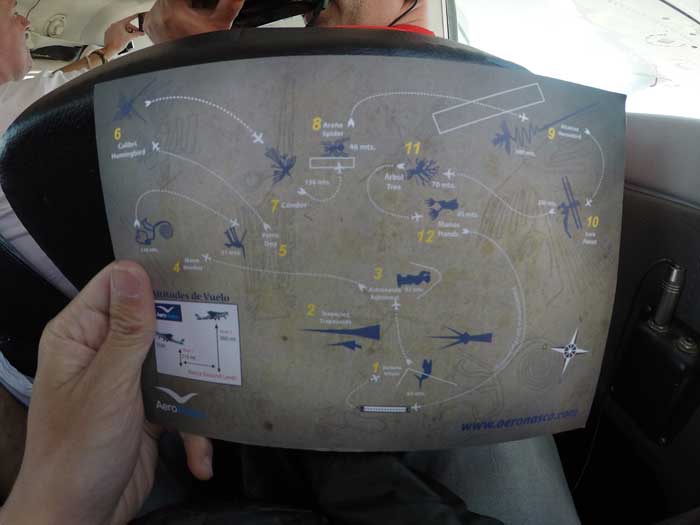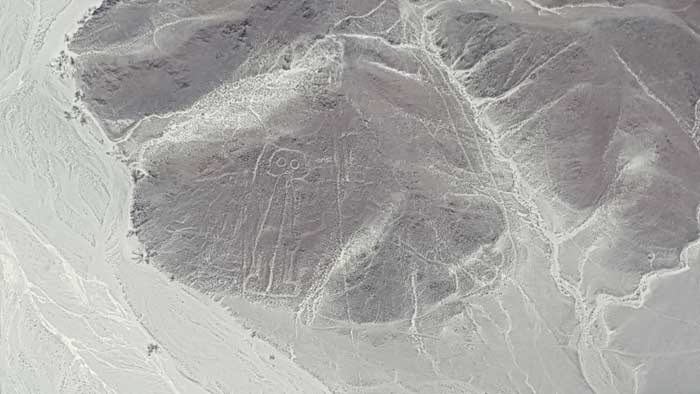“And on your right, is the famous Paracas Family,” the co-pilot announced over the speakers as we flew over the image of the ‘cutely-drawn’ family of 5.
Or was it 6? It wasn’t clear.
There’s the man – the head of the family – with a huge mane, like the rays of the sun and holding on a stick; a woman with her long hair till the waist, and two children who look more like rabbits to me.
Separated from the group is a small person, presumably the baby of the family.
The pilot circled around the family to the left, giving the passengers on the other side an equal chance to see the Family.
Now this is not something one gets to see every day, not even on the famous Nazca Lines flight. This is the lesser known Palpa Lines.

Mystery in Nazca
After 5 weeks in Cusco, I finally continued my journey to the coastal area of Nazca. The bus ride from Cusco through the winding mountains was the most nauseating in my whole trip, despite riding with the most luxurious bus company in Peru – Cruz del Sur.
The only reason anyone visits Nazca is for the Nazca lines - a mysterious gallery of geoglyphs in the arid desert of Peru, between the Nazca and Inca Valleys. This 37-mile long plain was declared a UNESCO Archaeological World Heritage Site in 1994.
And deserve the title they do.

These enigmatic lines are colossal and near-perfect in design and continue to marvel the world more than 1500 years after the ancient Nazca culture disappeared.
As massive as they are (the longest is 12km), they were only discovered in the 1930s – when aviation occurred in the area. The Pan-American Highway cuts through the desert and the thousands of people who passed by would never have guessed these lines even existed if not for the vantage point from high above.
"You simply can't see anything from ground level. You can't appreciate any of it from anywhere except from above. You can't tell me the Nazca builders would have gone to the monumental efforts they did without ever being able to see it."
Writer
This leads to theories of extra-terrestrials or prehistoric men aboard hot air balloons. How else was a pre-Inca culture be able to draw on a desert canvass of such immense scale?
Nazca Lines Flight
The two ways for tourists to view these lines are from a viewing tower and on an aerial flight. The tower, although strategically placed, only allows viewing of three of the main geoglyphs. If I’m only gonna do it once, I’d want to do it good.
I chose to go on a flyover and booked my tour with AeroNasca. I got picked up at the bus station the morning I arrived at Nazca and driven to the airport.
It seemed like many people shared my sentiments as the airport was crowded, the tours were overbooked and I waited over an hour for my turn to fly.

A Nazca Line flight lasts 30-45min and costs USD $80-$100. It was my lucky day as the company offered me an add-on for the Palpa Lines at only USD $40 to fill up the empty seats. So, you might want to leave out the Palpa Lines flight till the last minute too.
Do note that there is an airport tax of USD $10 and also ‘security screening’ like in an actual airport.
The plane allows for a maximum of 6 passengers plus two pilots – one for flying, another for being our ‘guide’. They proudly assured us of the prowess and safety of the plane in engine horsepower and technical terms a non-plane enthusiast wouldn’t understand.

Once in the air, any excitement was replaced by the nausea from the very turbulent flight. The build of the plane (very thin) coupled with the pilots’ intent to show the lines at the perfect angles, and all the acrobatic manoeuvres made my head spin and my stomach flip.
All these after the most nauseous bus ride of my trip.
With this deadly combination, I gave up trying to look through the lenses of my camera. Besides, my photos wouldn’t turn out pretty from that height and movements.
I actually hoped that the flight would end as soon as possible.
Nazca Lines
Soaring high in the sky, zooming left and right, the first shape came into startling view: a whale.
A whale?
How did someone in the fifth century know what a whale looked like? I didn’t know that whale-watching was a thing back in the days.
More figures include a spider, monkey, hummingbird and even an ‘astronaut’ or some say, an alien.

Besides these 70 or so biomorphs, the Nazca Lines also consists of around 900 geometric shapes: trapezoids, spirals, circles and numerous perfectly straight lines.
The huge rectangles that crisscrossed on the plains has a striking resemblance to an airport runway, leading to theories that they were meant for spaceship landings.

Undulating grey hills filled the dry desert while further away, grids of green and brown crops added some signs of life. The nearby town was dotted with the famous spiralling Nazca aqueducts.

I was more intrigued by the scenery than the lines.
Palpa Lines
After flying over the 12 main drawings of the Nazca gallery, we flew towards the Palpa region for another round of nausea-inducing excursion.
The Palpa Lines are often neglected and over-shadowed by her more famous sister, and were only discovered in 1997.
Yet interestingly, they were created several hundred years before the Nazca Lines!
The Paracas people – the creators – preferred anthropomorphic shapes; forms that were unfounded in the Nazca desert. These include a 500 ft sundial, a pelican and the aforementioned Paracas family.

Perhaps the most fascinating of all is the star-shaped ancient Mandala atop a remote mountain plateau with no direct observers.
A Mandala – in case you don’t know – is considered an ancient Indian ritual symbol and represents the Universe and the never-ending Life cycle. How did the Paracas people know of an Indian symbol?

And to carve it in extreme precision and detail, with an exact inner circle diameter as the outer squares?
Coincidence or divine intervention?
Another interesting fact of the Palpa Lines is that they are located on hill sides and ridges’ tips unlike the flat plains the Nazca Lines are on.

Archaeologists have uncovered how these lines were made. The Nazca Lines were ‘drawn’ by digging into the earth to uncover the white parts, while the Palpa Lines were created by piling rocks on top of the land.
The dry conditions of the desert allow the lines to be preserved. Anywhere else, they would’ve been eroded in no time and no trace of these ancient cultures would be left.
Two different cultures, two different methods, one same mystery.
WHY?
Why did these ancient cultures create these lines?
What are the purposes of these drawings?
Were extra-terrestrials or divine interventions involved?
There have been many speculations and theories throughout the years but nothing is certain. There were no written records, not even history written from the winners’ perspective.

- Some researchers believe that these geometric shapes and humanoid figures were a form of worship to the Gods who control natural forces like floods, droughts and earthquakes. It seems possible since this is a dry region and the climate is important for food sources.
- A related theory is that these lines were a result of the people drawing water from the ground for irrigation purposes.
- Similarly, scholar and hydrogeologist David Johnson and Steve Mabee believe that the lines are a giant map of underground water sources traced on the land. But that doesn’t explain the shapes and differences in canvass choices for the two different cultures.
- The American explorer Paul Kosok thinks that the lines act as a giant observatory and calls it the ‘largest astronomy book in the world’.
- American astronomer Gerald Hawkins disproved the theory by using computer, calculations and knowledge of astronomical events.

- The English explorer Tony Morrison suggests that the lines were similar to wayside shrines found in the Andes mountains, acting as guides for the faithful to meditate and pray.
- Alan F. Alford ‘concludes’ that the lines were made by Negroid slaves of the Tiwanaku culture - from the La Paz area in Bolivia- who then later moved north and founded the Chavin and the Olmec culture. His explanation? The overdrawn zigzag-formations.
- Christina Conlee of Texas State University wrote in an article in Current Anthropology that human sacrifices were used in religious Nazca ceremonies and the lines were somehow related.
- The most probable theory goes to Maria Reiche, a German researcher who dedicated her life to studying the lines. She believes that the lines were part of a vast astronomic calendar whose figures marked different solar phases.

Astronomic calendar, irrigation channels, extra-terrestrials or not, one thing is for sure: these lines are a world wonder and the true beauty lies in the mystery of it.
Nature has preserved it for thousands of years but men has begun to destroy it. Tomb-raiders seeking artifacts deface the lines while mining companies scar the terrain with their constructions and traffic.
Lives have been lost when tourists unknowingly entrusted their lives to irresponsible flight operators. The guys at WorldNomads have written a great guide on choosing a proper company.

sandstorm in the distance
Towards the end of my flight, a sand storm brewed in the nearby town. The pilots communicated with the control tower and hurriedly brought us back to safety.
watch a 1min highlight of the experience here
Mention Peru and images of the wondrous Machu Picchu ruins or the Andean mountain range of Huaraz come into mind. But Peru has many hidden gems too and the Nazca and Palpa Lines are something you should not miss.
Take a flight, amaze yourself and form your own theory. Or at the very least, flying nauseous on a turbulent flight is an experience in itself! Red tour

And now, it’s your turn.

